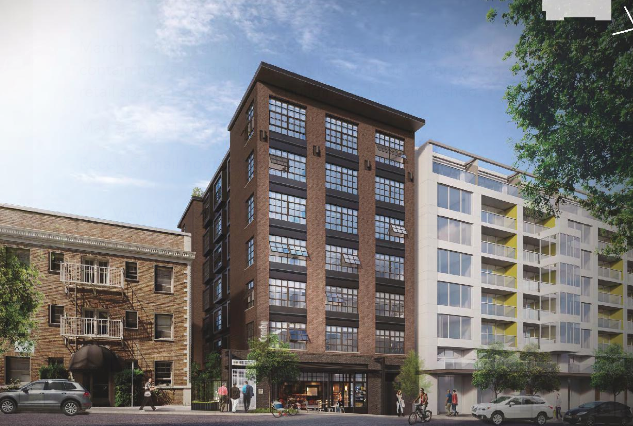Major changes to Seattle’s Design Review Program may be coming soon. Earlier this month, the Seattle Department of Construction and Inspections (SDCI) released a draft proposal that would make substantial changes to how the program operates. Key changes in the proposal include revised thresholds for design review, an added early public dialogue phase, a revised design review board structure, limits on the number of design review meetings, and a new “hybrid” design review process that blends features of Full Design Review and Administrative Design Review. SDCI’s draft recommendation and the proposals contained within it came about from a multi-year process to improve how the Design Review Program works. If adopted, it would be the first major revision to design review since the program was instituted
The Design Review Program has been a feature of major land use planning in Seattle since 1994. It was instituted as a way to get early public feedback in the design of larger residential and commercial developments instead of relying upon the State Environmental Policy Act (SEPA) process. The latter process–which is often still part of the overall land use process for larger projects–provides an opportunity for public comment, discretionary review, and conditioning. Minor changes have been made to the Design Review Program since it was instituted, including the addition of Streamlined Design Review as a special process for townhouse and rowhouse projects, but nothing approximating the level of changes in the SDCI proposal.
Last year, SDCI briefed the City Council on somewhat similar changes, but the proposal was put on hold so that attention to all things planning could be focused on Housing Affordability and Livability Agenda (HALA) land use and zoning policy. Other programmatic and corrective land use and zoning issues have also crossed the Council dais during that period, but the bulk of the issues have remained HALA-centric.
Current Design Review Program
The current Design Review Program has three distinct forms: Full Design Review, Administrative Design Review, and Streamlined Design Review.
| Design Review Type | How It Operates |
|---|---|
| Full Design Review | Full Design Review is performed as a public meeting before an individual design review board. Meetings are held in community buildings near the project location. Full Design Review has two distinct phases: Early Design Guidance (EDG) and Design Recommendation. Each of these include a public meeting with the local design review board. Meetings are noticed online, posted on-site, and mailed to residents and businesses nearby. The process allows for the public to provide written or oral testimony at meetings. Process and procedural guidance is given to applicants by City staff. Ultimately, the local design review board is entrusted with making a decision on design that may be appealable to the City Hearing Examiner. |
| Administrative Design Review (ADR) | Administrative Design Review is similar to the Full Design Review process, but is conducted entirety by administrative planning staff. The process is used for projects that are not otherwise subject to design review but seek to use departures from the Land Use Code. These projects are noticed for public comment, but there is no public meeting. Decisions on Administrative Design Review projects are issued by SDCI Director that may be appealed to the City Hearing Examiner. |
| Streamlined Design Review (SDR) | Streamlined Design Review was added as a design review process in 2010 and generally only applies to townhouse and rowhouse development. The review is conducted entirely by administrative planning staff and has fewer submittal and procedural steps than Full Design Review and Administrative Design Review. These projects are noticed for public comment, but there is no public meeting. Decisions on Administrative Design Review projects are issued by SDCI Director that may be appealed to Superior Court under the Land Use Petition Act; they may not be appealed to the City Hearing Examiner. |
The scope of a development proposal and whether or not departures from development standards are proposed generally determine which type of design review will be required. Certain uses are exempt from design review entirely, including schools, religious institutions, and human service providers. Zoning and special district overlays may also exempt new development from design review in lieu of the thresholds below. Examples of exempted areas from design review include single-family residential zones, most industrial zones, landmark districts that have their own special review processes, and Major Institution Overlay areas which also have their own special review processes.
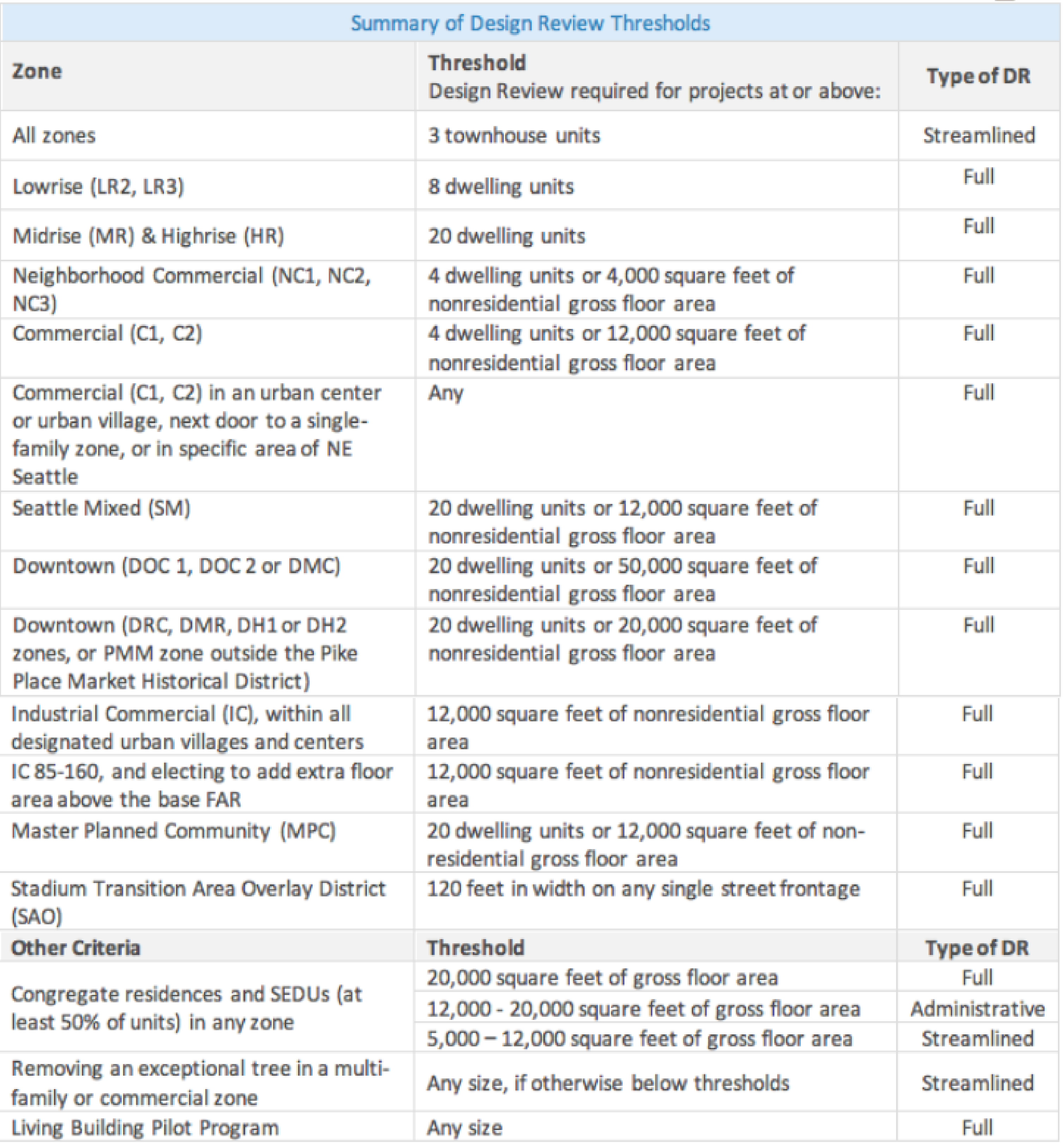
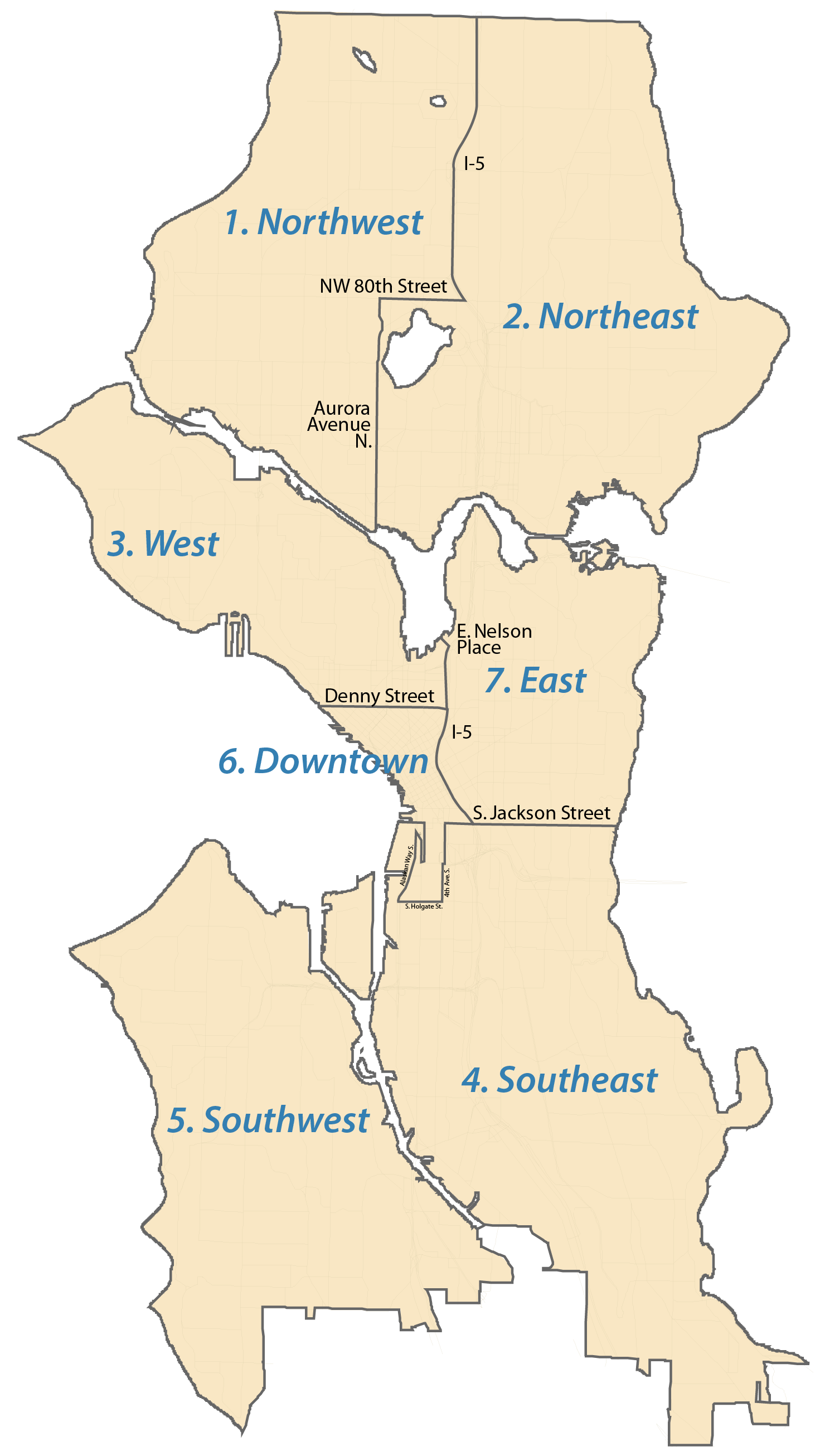
Design review is carried out by seven design review boards, which are carved out to cover common geographic areas of the city. Each design review board has five members that must represent specific interests. These include a design professional, developer, community representative, residential representative, and business representative. Under the City’s Get Engaged Program which helps identify young adults for boards and commissions, at least one Get Engaged member is assigned to participate in the Design Review Program as a local design review board member.
Proposed Changes to the Design Review Program
The SDCI proposal would make deep changes to how the program works. This includes reformulating thresholds for design review, requiring early community outreach, composition of design review boards and their structure, limits on design review meetings, and other technical changes.
The forms of design review would be revised into three categories: Full Design Review, Hybrid Design Review, and Administrative Design Review. This means that Streamlined Design Review would be eliminated as a process form.
The Full Design Review process would be the same as today, but subject to limitations on the number of meetings and require early community outreach. Administrative Design Review would also remain the same as today, except for an added requirement for early community outreach. Hybrid Design Review would be a step between these two design review forms. One Early Design Guidance meeting and Design Recommendation meeting would be required in addition to early community outreach. However, the Early Design Guidance meeting would be conducted by administrative planning staff before moving to the Design Recommendation meeting with the local design review board.
Site characteristics would be taken into account to help determine the type of design review that would be required for a development proposal in addition to specific thresholds. Any site characteristics that would apply to a site would mean that the site qualifies as “complex.”
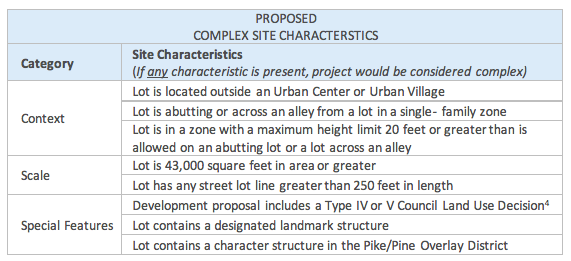
Projects that trip a threshold and are considered to have complex site characteristics would be subject to a higher level of public scrutiny through the design review process than projects that trip the same threshold but do not have complex site characteristics.
The thresholds for design review would be modified and include site characteristics factors to determine what type of design review process would be required for a project. Thresholds would be simplified by proposed development square footage. For residential development, this would remove dwelling unit density as a consideration of thresholds creating uniformity between commercial and residential development. Thresholds between zones would apply more consistently than the current structure which has more than a dozen different thresholds based upon underlying zoning.
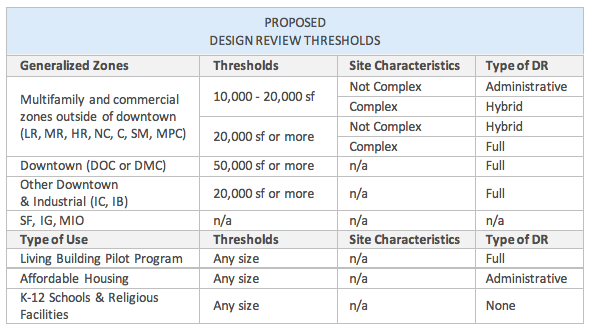
The changed threshold structure would also require many institutional uses to participate in design review whereas now they are not required to do so. This would mean community facilities likes libraries, community centers, and daycare centers would be subject to design review. However, primary and secondary schools would continue to be exempt from design review.
Development in single-family residential and Industrial General zones as well as properties designated with a Major Institution Overlay would continue to be exempt from design review, too. The proposal, however, would apply more broadly to development in Industrial Commercial and Industrial Buffer zones. Affordable housing developments that are funded by public money would be able to use a the Administrative Design Review process to reduced permit review timeframes.
The structure of the design review process would be altered by adding a pre-meeting requirement for early community outreach. SDCI notes its Director’s Report that the formal design review process, such as Early Design Guidance meetings, can have a significant impact in altering the direction of a building design proposal. Earlier engagement through community outreach could be an avenue to get feedback that truly informs the design process before a tentative set of designs comes to design review boards. Early community design outreach could also reduce added costs and delays that might otherwise come through the process later. Developers in some cases have sought to pursue voluntary early community outreach before going to design review (e.g., using the Pike Pine Urban Neighborhood Council and talking to community members at general neighborhood meetings).
The following are options that applicants could use to satisfy the early outreach requirement:
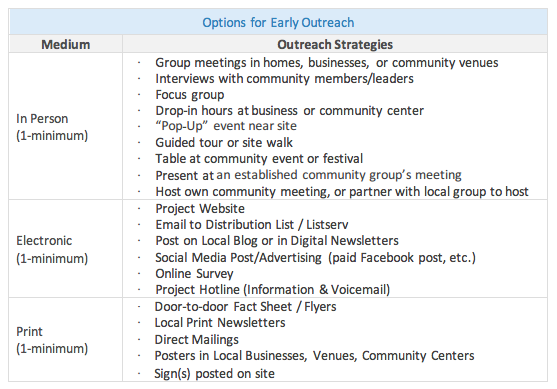
An applicant would have to use at least one strategy for each type of medium (in-person, electronic, and print) to satisfy the early community outreach requirement.
The composition of design review boards would change modestly under the proposal. Each design review board would continue to have five members, but the type of seats held by members on boards would change. The proposal from 2016 would have increased membership on boards, expanded expertise of members, and reduced the number of boards to five.
Seats allocated to “general community” representatives would be folded in with “local residential” representatives. Each board would have two such representatives holding a “local resident/community” seat. In place of the standalone “general community” representative category, SDCI is recommending that a Get Engaged representative category be added to encourage youth participation. Each board would have no more than one youth representative from the Get Engaged Program. The “local business” representative seats would be broadened to “general business or landscape professional” with each board one such representative. The “development” and “design professions” representative categories would remain unchanged with each board retaining one such representative from each category.
Additionally, the proposal would make it easier for SDCI to remove members from any board for just cause, such as failure of a member to attend at 90% of scheduled meetings or failure to attend on-boarding and orientation sessions for joining a design review board.
Design review board meetings would be limited by the type of design review process that a project would subject to, a change from today where there is no limitation.
- Full Design Review: maximum of two Early Design Guidance meetings and one Design Recommendation meeting.
- Hybrid Design Review: maximum of two Design Recommendation meetings.
- Administrative Design Review: no design review meetings.
However, the proposed limitations on meetings would not apply for projects seeking departures from the Land Use Code, abutting or locating across the street from a single-family residential zone, or submitted in conjunction with a Type IV or V land use decision (e.g., a contract rezone).
In the instance that the design review board does not positively recommend a project at the conclusion of the maximum number of Design Recommendation meetings, then the applicant could either request to hold an additional meeting with the design review board or work with the assigned project planner to resolve issues that the design review board has identified administratively. SDCI could also require an additional design review board meeting in certain circumstances (e.g., failure of the applicant to respond to design review board directions or a need for additional deliberation time).
SDCI’s Analysis of the Proposal
Analysis by SDCI indicates that the proposed changes would result in a modest reduction in the share of projects going through the design review process. The biggest change would be the number of projects going through Full Design Review. According to the Director’s Report:
The proposal would reduce the number of projects that would be required to go through Full [Design Review], allowing a large portion of projects to be reviewed through the Hybrid and [Administrative Design Review] processes. Under the proposal, 41% of projects would go through the Full [Design Review] process, 23% would go to Hybrid [Design Review], and 7% of projects would be reviewed through [Administrative Design Review]. The proposed minimum threshold of 10,000 sf would reduce the number of projects subject to Design Review by approximately 28%. The vast majority of these include fewer than eight units (83%) or are located in a Lowrise (LR2 or LR3) zone (82%).
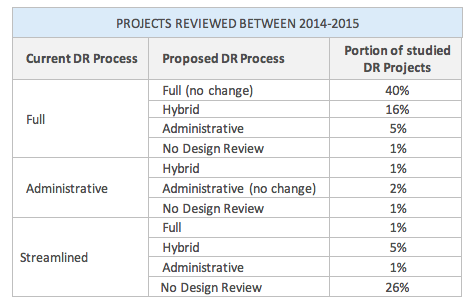
A large portion of projects would see only minor changes in the type of design review process required under the proposal. Over 40% would go through the same type of Design Review that they would today. With the addition of the proposed early outreach process, this would result in a greater amount of dialogue and public involvement than exists for these projects under the current rules.
The proposed list of complexity characteristics would allow approximately 30% of projects to move through a faster track of design review, allowing the Board to focus on the remaining 70% of projects that have one of the complexity characteristics. Similarly, the proposal would require 22% of the projects that are currently reviewed through the Streamlined process to go through another form of Design Review.
To get a sense of the kinds of projects that would be subject to different design review processes under current and proposed thresholds, SDCI provided a variety of examples scenarios for consideration in the Director’s Report:
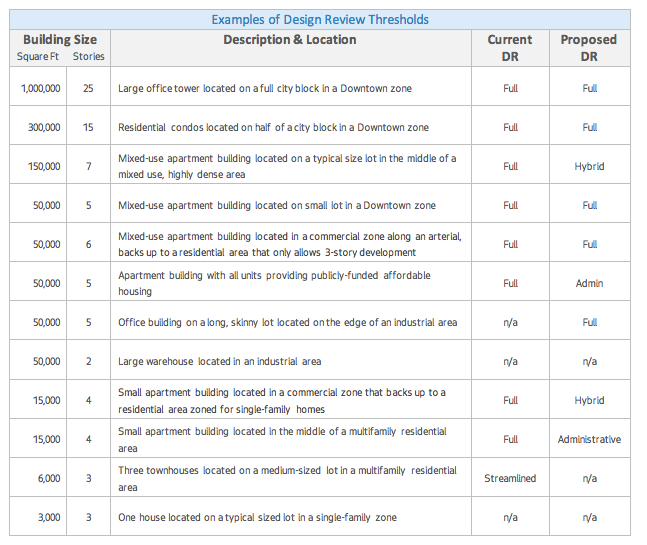
Next Steps
SDCI’s draft proposal to improve the Design Review Program is open for public comment through Monday, July 10th. Written comments on the proposal can be submitted to William Mills, an SDCI land use supervisor, who is managing that portion of the project. Appeals under SEPA will also be accepted through the end of today (Thursday, June 29th). Final recommendations will be transmitted to the Mayor later this year before being sent to the City Council for consideration.
The title image features the proposed Crosby development in Capitol Hill and is courtesy of B+H Architects.
Stephen is a professional urban planner in Puget Sound with a passion for sustainable, livable, and diverse cities. He is especially interested in how policies, regulations, and programs can promote positive outcomes for communities. With stints in great cities like Bellingham and Cork, Stephen currently lives in Seattle. He primarily covers land use and transportation issues and has been with The Urbanist since 2014.

